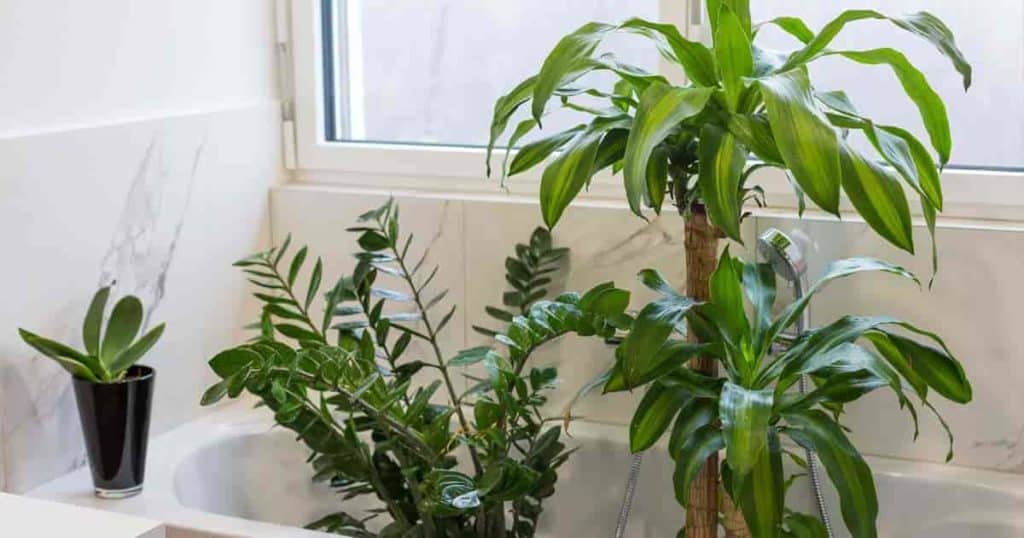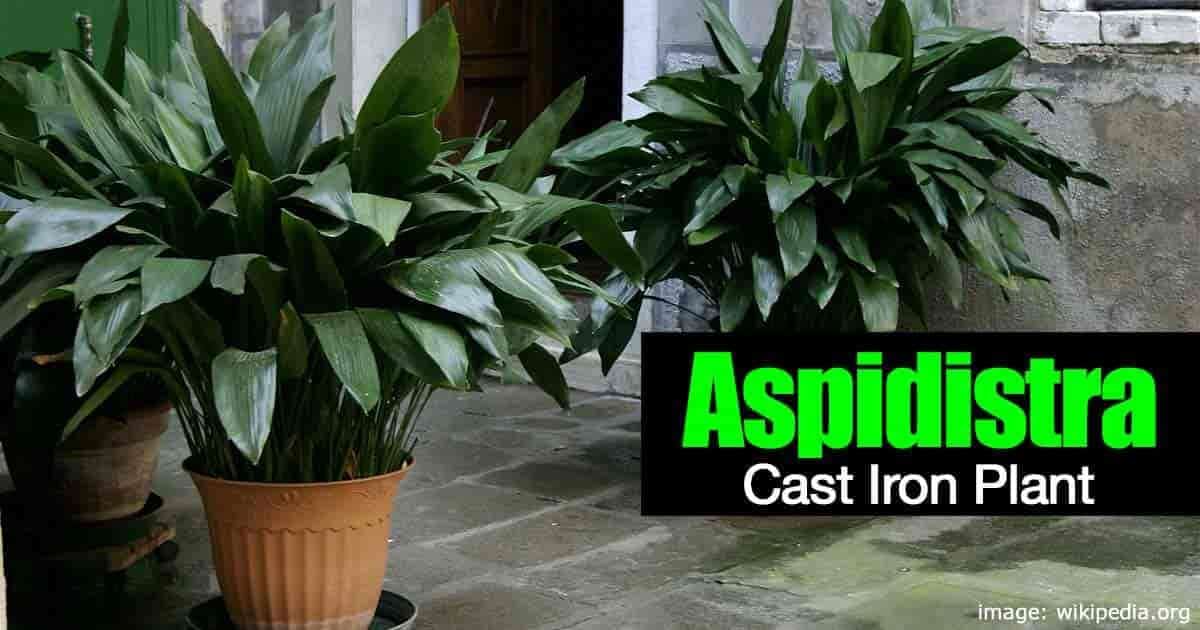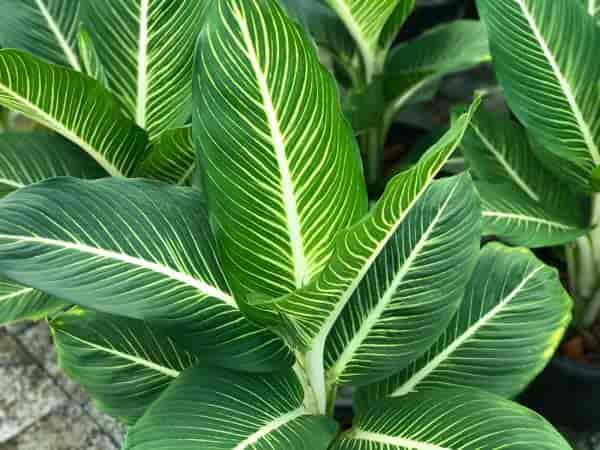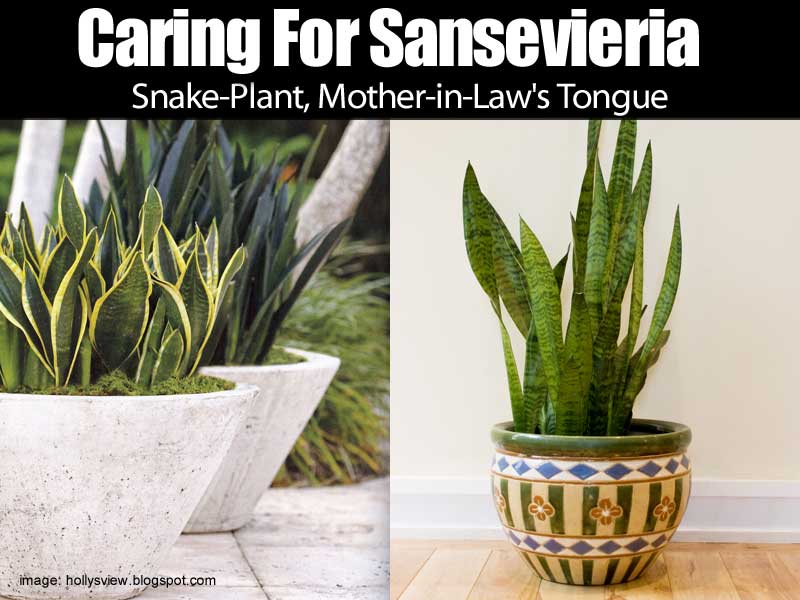There are lots of good reasons to have indoor plants, even plants in the bathroom.
They are beautiful, uplifting to look at and be around and they serve a practical purpose in keeping your home environment clean and healthy.
 Plants perfect for the Bathroom – Phalaneopsis Orchid, ZZ Plant and Dracaena
Plants perfect for the Bathroom – Phalaneopsis Orchid, ZZ Plant and Dracaena
Houseplants improve the air quality in your home by cleaning the toxins from the air. While it’s advisable to have indoor houseplants in every room, it is especially good to have them in the bathroom. Plants love the high humidity of the bathroom.
Even if your bathroom is dark and windowless, and even if you are a terrible plant keeper, you can have success by keeping the right plants in your bathroom.
Table Of Contents
- Can Plants Live Without Light In The Bathroom?
- Is It Expensive To Use Artificial Light?
- Managing Your Grow-Light
- Temperature and Humidity Levels
- What Are The Best Bathroom Plants To Choose?
- 9 Upright Plants For Windowless Bathroom
- #1 – Lucky Bamboo
- #2 – Ferns
- #3 Cast Iron Plant
- #4 – Chinese Evergreen
- #5 – Dieffenbachia
- #6 – Dracaena
- #7 – Philodendron
- #8 – Mother-In-Law Tongue | Snake Plant
- #9 – ZZ Plant
- #10 – Peperomia Plant aka The Radiator
- #11 – Calathea Burle Marxii
- 3 Trailing Tropical Houseplants
- Easy Care Tips Video
- 3 Lovely Flowering Plants For The Bathroom And No Light
- #1 – Begonias
- #2 – Orchids
- Easy-Care, Low-Light Succulents
- Placing Plants In Your Bathroom
- Green Your Bathroom
In this article, we will present the best plants for bathrooms that do well even in a low-light bathroom setting. We will also provide advice on caring for and displaying your bathroom plants perfectly. Read on to learn how!
Can Plants Live Without Light In The Bathroom?
The short answer to this question is “No!” All plants must conduct photosynthesis (the transformation of light to energy) to survive and thrive. However, some plants need less light than others to do this. Therefore, success with good bathroom plants begins with choosing the right plants. You can approach this process from several different perspectives.
- Choose a bathroom plant that will naturally tolerate low light. Understory plants hailing from rain forest settings do quite well in the high humidity, low light environment common to many bathrooms. Air plants (bromeliads) and some succulents can also do well in these circumstances.
- Use a grow-light and/or overhead fluorescent lighting to add needed light to your bathroom and expand your choices.
- Rotate plants in and out of your bathroom to give them turns at a sunny window elsewhere.
- Buy cheap plants and simply toss them and replace them when they die from lack of light (this is especially cruel, and shame on you if you do this!)
- Throw your hands in the air and purchase silk or plastic plants. This is also a dreadful option as you will reap no air purifier benefits from having artificial plants in your home and the manufacture of these impostors is very bad for the environment in general.
Carefully choosing live plants and providing them with proper lighting as needed is the best way to go. Luckily, there are lots of suitable plants to choose from. Under-story rainforest plants, bromeliads, epiphytes and even some succulents do very well in low light and humid environment.
Is It Expensive To Use Artificial Light?
I have not found plants that do not need sunlight. Providing your bathroom houseplants with artificial plant grow lights is one of your options.
The lighting is affordable and can benefit you, as well as your plants. You can replace the bulbs in your bathroom with full-spectrum bulbs for just a little more than you would pay for regular light bulbs.
Full spectrum bulbs allow you to enjoy a better quality of natural light in your bathroom. Exposure to full-spectrum lighting is a proven mood elevator and is prescribed as a treatment for Seasonal Affective Disorder (SAD) which causes wintertime depression.
Use these bulbs in your overhead light fixture.
You can also get full-spectrum CFL grow light bulbs at a quite affordable cost. It’s not a good idea to put these bulbs in your overhead socket for a couple of reasons. First, flipping them on and off causes them to wear out quickly.
Second, it‘s best to have these bulbs close to your plants for superior results.
You can use these convenient bulbs in any lamp to place them close to your plants to provide bright light directly to the plant and create an attractive growing space for the plants in your bathroom.
Use these bulbs to provide natural, bright light to your plants.
Keeping a grow light bulb or two burning continuously is quite inexpensive (pennies a day) and the benefits you reap from having healthy plants thriving in your bathroom more than justifies the expense.
If your bathroom is truly windowless or very dark, keeping a source of full spectrum light burning will also make the room more comfortable and inviting for you and your guests.
You may also be happy to know that almost all the plants that do well in a bathroom setting reproduce with rather wild abandon when well-kept. If you take good care of your bathroom garden by giving it ample artificial light and the recommended occasional watering, you will be able to give your friends living plants on almost every gift-giving occasion! Think of the money you’ll save!
Managing Your Grow-Light
For bromeliads and epiphytes, overhead full-spectrum lighting left on for about 12 hours a day may be enough. For plants with a greater need for light, place a grow light bulb in an attractive lamp or light fixture placed close to the plant and make your lighting part of the décor.
You can leave your grow-light burning continuously or set a timer like this Fitnate to limit it to 12 hours daily. Use of a time will make management of your light automatic so you won’t have to be bothered with it.
Temperature and Humidity Levels
For your comfort, you probably keep the temperature in your bathroom fairly consistent. The general rule of thumb for most house plants is if you are comfortable your plant probably is too.
If your current habit is to keep your bathroom cold except when you plan to take a bath or shower, you’ll need to alter that if you want to keep plants happy. Keeping a small heater running on a low temperature setting (or programming your smart thermostat to keep your bathroom at a comfortable temperature) is beneficial to you and your plants.
Humidity levels in the bathroom naturally vary quite a bit. The humidity will rise quickly and briefly whenever you take a shower. Luckily, this is very good for many tropical plants, bromeliads and some succulents in terrariums. In some instances, you may need to provide a little more humidity by misting your plants.
What Are The Best Bathroom Plants To Choose?
Choices in plants that will do well with low lighting, consistently comfortable temperature and reliable levels of humidity abound. Here are some of the best choices in low light bathroom plants in succulents, bromeliads, epiphytes, and tropical plants to brighten your bathroom décor.
9 Upright Plants For Windowless Bathroom
#1 – Lucky Bamboo
 An inexpensive and easy to find at garden centers, grocery stores, dollar stores, convenience stores, car washes and gas stations and many other venues. It is easy to grow and enjoys a low-light setting.
An inexpensive and easy to find at garden centers, grocery stores, dollar stores, convenience stores, car washes and gas stations and many other venues. It is easy to grow and enjoys a low-light setting.
You don’t even need a potting mix to grow the lucky bamboo plant – Dracaena sanderiana. Just purchase a few shoots, take it home and pop it into a container of pebbles or marbles and filtered water (or water that has been allowed to sit out overnight to allow chemicals to dissipate). Change the water weekly to prevent mold growth.
This type of plant grows very quickly, but you can keep it the size you want by trimming it regularly or by placing it in an area that hampers its growth. For example, you might put a shelf above it.
#2 – Ferns
True ferns such as Bird’s Nest fern (Asplenium), Boston fern (Nephrolepis exaltata) and Staghorn ferns do very well in low-light bathroom settings.
Another is the “asparagus foxtail fern” not a true fern but its look has earned it the name. They like indirect, natural light so a bathroom window is desirable but a full spectrum grow light will also work.
Ferns make great shower plants. A fern loves humidity from your showers, but they also need regular watering and misting. Remember to check the soil and keep it lightly moist (not soggy) at all times.
#3 Cast Iron Plant
Aspidistra elatior – the cast iron plant is an excellent choice if you are a notorious plant killer. This plant likes a low light setting and can tolerate a neglected watering schedule aka those forget to water. It can tolerate extremes of temperature (50°-85° degrees Fahrenheit). Naturally, as with all living things, a consistent temperature is appreciated.
 To take good care of aspidistra, place it in an area with indirect sunlight and water it thoroughly when the soil becomes bone dry.
To take good care of aspidistra, place it in an area with indirect sunlight and water it thoroughly when the soil becomes bone dry.
Wipe the long, spear-like leaves with a damp cloth from time-to-time to keep them dust-free. If your bathroom is windowless, provide artificial light.
The Aspidistra plant is attractive and comes in both dwarf (18 inches) and full-size (2-3 feet high) varieties. Leaves may be dark green, yellow striped or dotted with yellow.
#4 – Chinese Evergreen
 The Aglaonema is a lush, leafy plant with large leaves variegated with white or pink markings. You will often see this plant in a mall or office settings because it is tough and beautiful and it loves a controlled indoor environment. It is a tropical plant, and your bathroom is the perfect place for it!
The Aglaonema is a lush, leafy plant with large leaves variegated with white or pink markings. You will often see this plant in a mall or office settings because it is tough and beautiful and it loves a controlled indoor environment. It is a tropical plant, and your bathroom is the perfect place for it!
#5 – Dieffenbachia
The “Dumb Cane” is similar in appearance to Chinese Evergreen and Aspidistra plant, but it much bigger. Its leaves can grow to be a foot long or more.
The lighting needs in Dieffenbachia care provide artificial light and/or bright indirect light to thrive. It needs protection from direct sunlight. It also likes high humidity and consistently moist well-drained soil.
If you have the unusual circumstance of having a large, windowless bathroom and you want to create the illusion of a well-lit, tropical setting, this plant will do well for you.

#6 – Dracaena
The “Dragon Plant” comes in more than forty varieties. It’s long, spear-like leaves range in width from very fine and thin to a couple of inches wide.
Available in solid green, greenish-maroon, and variegated colorations. The leaves emerge from relatively thick, trunk-like stems.
This plant is a real workhorse as air purifying plants for bathrooms. It prefers artificial light to natural light and will scorch in bright sunlight.
This low-care plant does very well with just the high humidity levels you would expect to find in a bathroom.
One of the plants that dont need light variety, in particular, to consider as a “low or no light plants” is the dark green Dracaena Janet Crag “Compacta.”
#7 – Philodendron
The “philo” comes in many shapes and size. Large and small, medium-light, low care tropical plants with glossy green, variegated and even maroon colored leaves.
The split-leaf variety sometimes known as Monstera. Heartleaf philodendron with its heart-shaped leaf is a long-time, popular favorite.
All types of philodendron prefer consistent, moderate lighting, so artificial lighting is the best choice. They also need a consistently warm temperature, so plan to keep your bathroom between 75° to 85° degrees Fahrenheit.
#8 – Mother-In-Law Tongue | Snake Plant
 Sansevieria (aka: Snake Plant or Viper’s Bowstring Hemp) is a very familiar standby. The snake plant is a tough customer that grows in tall, upright, rigid spears of dark green with darker green striping and white or yellow edges. The snake plant is a NASA star in terms of an air purifier, and it tolerates all manner of abuse.
Sansevieria (aka: Snake Plant or Viper’s Bowstring Hemp) is a very familiar standby. The snake plant is a tough customer that grows in tall, upright, rigid spears of dark green with darker green striping and white or yellow edges. The snake plant is a NASA star in terms of an air purifier, and it tolerates all manner of abuse.
The snake plant will do well in light levels ranging from low to bright indirect lighting. It will also do very well with fluorescent or grow lights. It is fine in most humidity levels and needs infrequent watering. A favorite plant for bathroom settings. The Birds Nest Snake Plant is perfect for the bathroom.
#9 – ZZ Plant
Zamioculcas zamiifolia – Known also as the Eternity Plant or ZEE ZEE Plant – is a sturdy South African plant that can tolerate a wide variety of conditions. The zz plant does not like direct sunlight or very deep shade, but if you can provide any level of indirect light or artificial light, it will be happy.
ZZ is a drought tolerant plant, but it will do best if you water it thoroughly when the top inch of the soil becomes dry. If you do forget and it begins to drop leaves, give it a good watering, and it is sure to bounce back.
ZZ has thick, glossy, dark green leaves that grow on long fronds. It is a very attractive plant that attains a maximum height of two feet.
#10 – Peperomia Plant aka The Radiator
The Peperomia plant with about 1,000 species has been popular as a small houseplant for decades. With all the species available only a handful are grown commercially.
One of the most popular species with many sports and cultivars is Peperomia obtusifolia (baby rubber plant). Sometimes called the baby rubber plant, Peperomias make nice additions to a bathroom.
Peperomia care is easy. They like humidity, withstand lower light levels, and don’t like over-watering. You’ll find many small varieties perfect for bathroom use.
All but one of these choices in upright, low-light plants are practically indestructible. Ferns can be a bit delicate, so if you want a truly carefree plant, you may wish to avoid them.
#11 – Calathea Burle Marxii
Calathea plants display long, broad, pointed leaves and highly colored. They make wonderful centerpieces and even the underside of the leaves are interesting.
One varieties well suited for bathroom culture is Calathea (Stromanthe amabilis) Burle Marxii. A low grower and perfect in small pots.
Love Plants But No Sunlight? These 15 Plants can Be Your Best Buddy
3 Trailing Tropical Houseplants
#1 Ivy of all types do an incredible job of air purification. In fact, NASA rated ivies among the top plants for helping keep ambient air free of bacteria and mold.
The English Ivy plant with its many leaf forms and the durable grape ivy (Cissus) are two of the hardiest and most common types of ivies grown as a houseplant.
Many different types of ivy do very well in hanging baskets or trailing from a high shelf or windowsill in a bathroom setting.
The choices in leaf shapes, shades and coloration are nearly endless. These plants do well with moderate natural light or with artificial light.
#2 – Spider Plant (Chlorophytum comosum) also gets a high score from NASA when it comes to cleaning the air.
The sturdy, attractive little spider plant has been found to remove formaldehyde from the ambient air.
Spider plants are available in both an attractive solid green and a light green color with yellow stripes.
Their leaves are long and spear-shaped, and they send out runners upon which a baby spider plant grows if the plant is getting enough light.
More –>> Learn the How To’s of spider plant care
 Spider plants can do well in bathroom lighting; however, they will not send out runners with too little light. To thrive, moderate to bright indirect light levels are preferable.
Spider plants can do well in bathroom lighting; however, they will not send out runners with too little light. To thrive, moderate to bright indirect light levels are preferable.
This plant will do well at normal bathroom humidity levels. Water thoroughly when the top one-inch of soil feels dry.
#3 – Pothos Plant (aka: Devil Ivy or Epipremnum aureum) is a familiar, ivy-like plant available in a variety of leaf colors from bright, solid green to attractively variegated yellow and green. This rugged plant grows quickly and abundantly from cuttings, and everyone has seen it growing in schoolrooms, on kitchen windowsills, and in other humble settings.
The bathroom is the ideal setting for Pothos. It loves low filtered light, ample humidity, and a relatively stable temperature. It can be pruned to make a bushy plant or hung in a basket or set on a high shelf for a rampant, trailing effect.
All of these trailing plants come in several varieties making it very easy to choose just the right size and appearance to suit your setting. [source]
Easy Care Tips Video
Although the five plants shown in this charming video are not billed as plants for the bathroom, they do all appear on our lists.
Video: Collection of Easy & Low Maintenance Houseplants
3 Lovely Flowering Plants For The Bathroom And No Light
#1 – Begonias
The Begonia are indoor plants that need no light and makes a perfect choice for a windowless bathroom because they prefer fluorescent or full-spectrum artificial light to natural light. They also like ample humidity and may require misting, even when kept in a bathroom. [source]
These lovely, showy plants come in a wide variety of blossom colors and types. Their fleshy, semi-succulent leaves are also attractive and come in several shapes, sizes, and shades.
Related Reading: Growing Begonias For Hanging Baskets
#2 – Orchids
Orchids are great plants that require no sun and inarguably elegant and shockingly easy to care for. If you have been wondering “Where should I put my orchid?” look no further than your bathroom.
Orchids like high humidity, indirect sunlight or artificial light. They need protection from bright, direct sunlight. Because they appreciate higher humidity levels, these compact beauties are a perfect choice beside your sink or on the side of your tub. Keeping phalaenopsis orchids in a bathroom is easy.
Video: How to Grow Orchids Indoors
#3 Peace Lily Spathiphyllum
The Peace Lily plant is another very beautiful and elegant looking plant that sports glossy leaves and lovely white blooms. This plant is also a top NASA pick in terms of filtering out chemicals (i.e. formaldehyde, trichloroethylene, benzene) in the environment.
Peace lilies make good plants for bathrooms and are relatively large, so they make good candidates for floor planters. The peace lily likes indirect sunlight or artificial light. Daily misting is recommended.
These are by no means the only flowering plants available for a small, low-light bathroom setting. Many of the other choices also produce flowers. The peace lily is just one of three of the most flamboyant. [source]
Air Plants: Tillandsias, Bromeliads, and Epiphytes
Epiphytic plants are also good low-care candidates for a humid bathroom setting with low-to-moderate lighting. These types of plants (Tillandsia “air plants”) do not need soil to thrive. In nature, they attach themselves to trees via very shallow roots and glean all their moisture and nourishment from the surrounding air. [source]
For this reason, they do need ample humidity and/or daily misting.
Orchids and Staghorn Ferns are epiphytes. Other examples include Spanish Moss and jungle cactus, such as Mistletoe Cactus (Rhipsalis) which does very well kept in a terrarium setting.
Drunkard’s Bones (Hatiora salicornioides) is related to Mistletoe Cactus and is also a good candidate for a countertop terrarium or hanging like this, ventilated glass globe. This compact plant provides a great deal of visual interest.
Most bromeliad plants and epiphytes are compact (except Spanish moss, which tends to trail and drape enthusiastically).
Small bromeliad plants can be used in a wide variety of artistic ways in a bathroom setting. They are very good for wall mounted frames or open, hanging terrariums.
There are thousands of species of bromeliad (air plant) and epiphytes, and most would be good candidates for a small windowless bathroom equipped with fluorescent lights, full spectrum lights and/or grow lights.
 These equatorial plants are happy with about 12 hours of filtered light daily and consistent temperature of about 65° degrees Fahrenheit.
These equatorial plants are happy with about 12 hours of filtered light daily and consistent temperature of about 65° degrees Fahrenheit.
Try making a bromeliad garden for long-term, easy care color all year round.
Easy-Care, Low-Light Succulents
Check Out PlantCareToday’s expanded plant list of Low Light Succulents
#1 – Aloe Vera is an excellent plant to have in any home. It is attractive and useful. The gel contained in its spears possesses tremendous healing qualities and can be used as a salve on bug bites, minor cuts and bruises, sunburn and more.
There are several different varieties of the Aloe plant, so you can create a varied display using aloe exclusively. All varieties do well in a low lighting that provides a consistent temperature but prefer bright light.
Aloe’s water needs are so low that it may do well just getting its water from the humidity in the air. Keep an eye on it, though. If it begins to look withered, give it a drink.
#2 – Haworthia is a South African genus of low-light succulent plants that contains over seventy species.
Most of these plants are compact, and easy to grow in a low light setting. They require little water and are ideal candidates for terrarium growth in a humid environment with limited space.
Like aloe plants, Haworthia succulents may do well simply gleaning their water from the humid condition of bathroom air.
The choices in both aloes and haworthia are many and varied. You may wish to make a focused collection of these two types of carefree, low-light succulent plants.
Even if you just stick to these specific types, your collection can be incredibly complex and interesting. [source]
Placing Plants In Your Bathroom
How you position plants in your bathroom depends on the layout of the room. If you have a window, it’s good to locate your plants near it or on the windowsill. If not, other good places include tub-side, on the countertop beside the sink and on the toilet tank.
If you are into Feng Shui for the bathroom and toilet, you know that placing a plant on the toilet tank is advisable. Additionally, setting up a plant corner in the left corner of the room as you enter is recommended. [source]
Plants (especially Lucky Bamboo) on the back of the toilet and strategically placed in a “money corner” are believed to attract wealth and prevent squandered resources and loss of money.
If you are strapped for space, hanging plants are always nice. This is especially true if you have a skylight. It is also possible to mount plants in a wall frame to save space and create a stunning visual effect.
Green Your Bathroom
Even a tiny, dark bathroom that is little more than a “water-closet” can become attractive, inviting and healthier by adding living plants. While plants do require light to live, there are many plants that actually do well in lower filtered light or artificial light.
Refer to the information presented here to select the right plants for your bathroom environment and set them up in an attractive and healthy home where they can thrive.
 Plants perfect for the Bathroom – Phalaneopsis Orchid, ZZ Plant and Dracaena
Plants perfect for the Bathroom – Phalaneopsis Orchid, ZZ Plant and Dracaena





